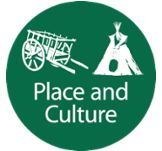Introduction

Permission: Courtesy of Kristin Moskalyk, Gwenna Moss Centre for Teaching and Learning, Flexible Learning and Technology, based on https://www.canva.com
The importance of land, of place, of belonging to a certain locality is of paramount importance when it comes to understanding and appreciating Indigenous worldview and culture. First Nations, Inuit and Metis peoples are intimately connected to the land, as are many Indigenous peoples around the world. Being able to survive and thrive as humans, as families and as communities depended on a deep and thorough knowledge of the land, the waters, the animals and the plants; the surrounding environment in its totality. When one has grown up in a harsh and sometimes hostile environment, there is an ingrained respect for the land, the weather and the animals that inhabit the same space.
This is in comparison to the Eurowestern worldview of using the land and waters for a purpose, such as farming, mining and other forms of resource extraction. Changing the surrounding environment to meet the needs of the person, family, and community is commonplace and expected. Purchasing, selling and owning the land is also a central tenet to the belief system. Eurowestern worldview operates within a hierarchical structure, and humans are at the top of the hierarchy, everything else in creation is there for them to access and use. The one who owns the most land is also the richest and at the top of the hierarchy, land is seen as a source of economic gain.
Whereas, Indigenous peoples believe that they belong to the land, the land does not belong to them. Kikawinow aski (Cree for Mother Earth) – all Indigenous peoples share a similar phrase in their own traditional language – encompasses not only the land but also the waters, the air, and the clouds. And similar to how babies relate and depend on their mother, so do Indigenous peoples relate and depend on kikawinow aski.
Some philosophical underpinnings of land based peoples include: relationships, observation, reciprocity, locality and oral transfer of knowledge.
The Elders are the caretakers, nurturers, developers, etc. of the relationships Indigenous peoples have with everything. Elders also believe it is their responsibility to be caretakers of the land; this process plays out in the everyday rituals and activities of living close to the land, and fostering an attitude of humility and deference. As the knowledge keepers of the communities, the Elders share their knowledge by showing and by role-modelling the relationship everyone needs to establish with the Earth.
Land based traditional knowledge is a component of culture. Culture is the values and beliefs that a People use to understand and function in the world. This culture manifests itself in a People’s language, customs, foods, religion/spirituality, music, arts and other characteristics that define a certain group of people (Hofstede, 2001). Land based peoples’ lives revolve around the land, the waters, the animals and all components therein; thus their culture is defined by the land. Place and culture are inextricably intertwined, one cannot survive without the other.
To honour the Indigenous communities of Saskatchewan and their local knowledge, we made trips to the communities and interviewed Elders, Knowledge Keepers and leaders on how their communities came into being. We asked them to share their stories of their homes, their places and what keeps them there; in their words and their languages. These are their histories of place and culture and the truth of how they came to be where they are.
By the end of this chapter you should be able to:
Chapter Outcomes:
- Examine how land, culture, and language are a part of culture and consider the impact on community when one of these pieces are lost or excluded.
- Identify the impact of government policy on livelihoods of people from marginalized populations.
- Recognize challenges faced by peoples of the North and unique opportunities made available.
Works cited
(1). Littlebear, Leroy (2000). Jagged Worldviews Colliding.
http://www.learnalberta.ca/content/aswt/worldviews/documents/jagged_worldviews_colliding.pdf
(2). The Canadian Encyclopedia. (2019). Inuktitut Words for Snow and Ice.
https://www.thecanadianencyclopedia.ca/en/article/inuktitut-words-for-snow-and-ice
(3). Hofstede, G. (2001), Culture’s Consequences: Comparing Values, Behaviors, Institutions, and Organizations Across Nations, 2nd ed. Sage, Thousand Oaks, CA.
